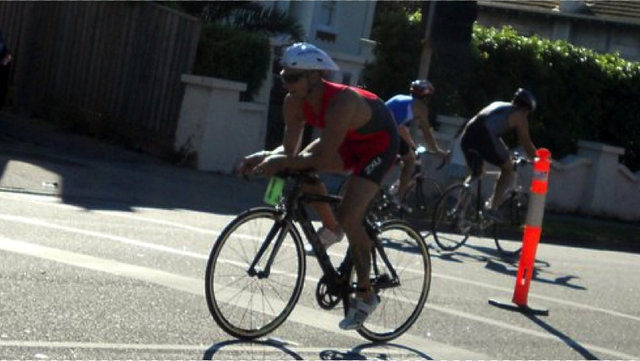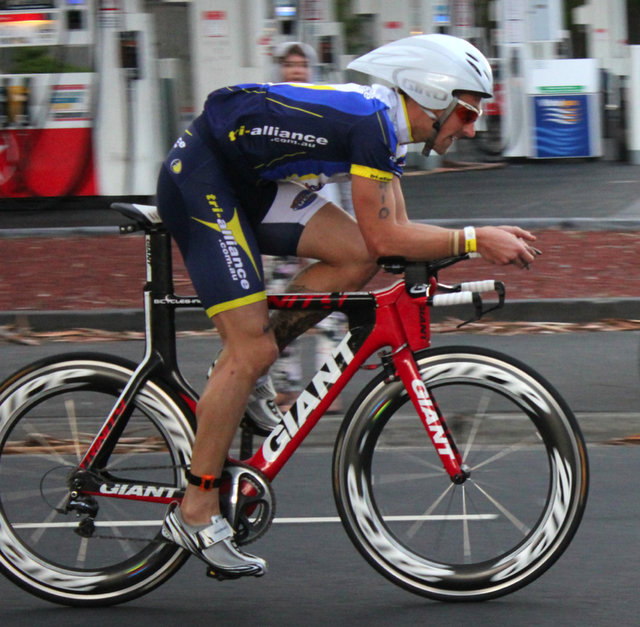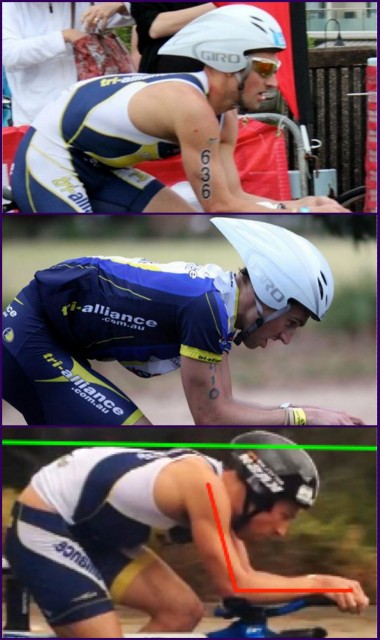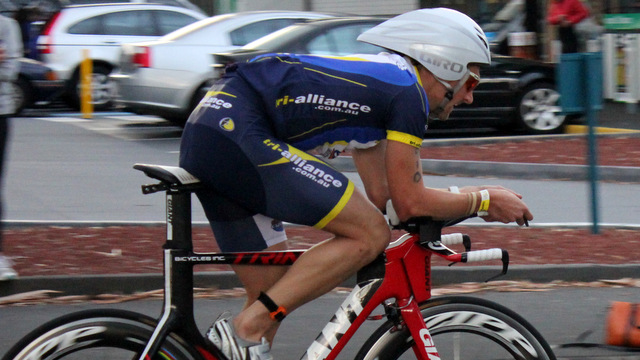In Part 2 of this series focusing on the bike Time Trial leg of Triathlon we are presenting an interview with Ryan Bourke, a 27 year old rising star in domestic triathlon, marketing manager at Tri Alliance, high performance triathlon coach, and all round good guy. Ryan will provide some insight into what it takes to be one of the top riding age-group and open-category triathletes in Australia.
Ryan thrust himself into his first triathlon in 2010, at the ripe old age of 23, and with little preparation, making it a tough first race. However, this did nothing to slow the rush of feel good endorphins following the race. Since then his success and dedication to the sport has grown. Despite having limited training hours due to balancing full time work, coaching and marketing for a number of organisations, Ryan has risen to the top of his age group as well as open categories in triathlon racing. This year Ryan placed first for his 25-29 age group and was the second fastest age grouper of the day at the inaugural Challenge Batemans Bay Triathlon with a lightning time of 4 hours 16 minutes.
Coming from a swimming background it is a difficult task to develop your cycling and running in order to become a successful triathlete. Ryan managed to do this very well and tells us about how we went about getting his body conditioned and his bike set up for the cycling leg of triathlon.
After moving on from his basic road bike, Ryan began riding a time trial bike (for those not aware these bikes have central handlebars and gears to position the rider in a more aerodynamic position). Ryan admits he was a rookie when it came to getting his bike set up for his first triathlons. He sought help online from the always helpful YouTube. Figuring he was fairly flexible from his swimming background he searched for what the pros looked like and set his bike up similarly. This position served Ryan well for one season. Following this he signed with triathlon training squad Tri Alliance. This lead to a professional bike fit which Ryan speaks highly of, not only in achieving a better position but in educating him on how to ride in the position whilst staying relaxed and pedaling efficiently.

Ryan later decided to alter his bike position to reflect his adjusting body. “Over time I became a more efficient rider, and was able to lower the front end. I believe this is due to better core strength development and being more stable through the hips on the bike. Over time I also moved further forward over bottom bracket, around 90 degree humeral-torso angle. Lowering the front end each season 5mm.”
For most people making these adjustments is best done in consultation with someone experienced in bicycle fitting, to avoid risky changes. Ryan shares learning this the hard way. “I once lowered the bars too significantly, which caused hamstring cramping and I couldn’t run due to hamstring tightness. Could be a lesson in this for home tinkerers”.

It is always interesting to have some insight from a coaching and participating athlete. Ryan’s experience coaching triathletes without a swimming background has highlighted the importance of good ankle and shoulder range of motion. He has suggested regular remedial massage being very helpful. Also, Osteopathic joint mobilization can help here and also direct some home exercises to maintain and progress this motion. Whilst some self-implemented strategies are great, Ryan recalls the humorous anecdote of an athlete with tight muscles reducing their ankle range of motion, causing numb toes through reduced blood flow. The athlete decided to wear booties in an attempt to rectify this in the middle of summer.
Ryan faces a challenging task of training athletes from the office whose job is predominantly sedentary. “Desk bound triathletes commonly have issues with hip stability, they can then have problems running with excessive pelvic drop and knock knees in cycling. ITB issues can then arise”. This is where manual therapy can be very valuable in not only limbering up the body for triathlon, but in devising strategies aided at injury prevention.
Some tips Ryan shared to help relax into an aerodynamic position were regular stretching, becoming more flexible through the upper back by extending on a foam roller, and not tensing while riding on the aero bars. “Relaxing on the aero bars and not grabbing them too tight is essential. You must learn to allow your hands, forearms and shoulders relax so you are not activating unnecessary muscles”. Doing this can help avoid unnecessary energy usage.
Ryan actively sought feedback from peers and also spoke with top level cyclists for input into his time trial position. “I realised it’s no good being in an aerodynamic position if you cannot hold this position due to pain and discomfort. I used self-analysis through photos and videos of races to monitor adjustments. I returned for a second bike fit to gain some more insight into my angles, the results were pleasing”.
It is interesting to hear that Ryan did have some challenges adjusting to the position and he realised that he had to focus on some specific strength training. “I had to implement core strength work, as my lower back would give me grief. I worked on glute, back, and torso strength. This was a 4 years progression. I also noticed shoulder and neck pain with the elbow pads being too narrow when riding”. It is valuable to hear from such a naturally talented athlete that it can still take years to develop this specific strength. It cannot be expected to have significant results from a single six week strength program for example.
Ryan generally recommends stretching 2-3 times per week if training 7+ sessions per week. He recommends stretching after a swim and hot shower, especially for people with flexibility issues. Ryan emphasizes that body maintenance needs to be treated as a training session, not just an option. He suggests prioritising body maintenance over training at times. He advises that when a ‘niggle’ does appear people should seek advice from someone who can diagnose a problem and offer management strategies to get it sorted. His suggestion for beginner athletes to get a proper body analysis is interesting. Hopefully this could result in early detection of weaknesses and flaws in technique to detect injury susceptibility.
Ryan himself sought assistance from a myotherapist at times to manage muscle issues, who could then refer on to an Osteopath or other health practitioner if required. “I had plantar fasciitis through changing my run technique, my myotherapist referred me on to have it more thoroughly assessed. This enabled me to manage it and I was back running with some rehab within 2 weeks”.
A training strategy Ryan recommends and uses himself to great effect is to “ride on the aerobars as long as can if you are racing on aerobars. Only coming onto the base bar if you are in pain or discomfort or conditions rectify this. If there is pain or discomfort on the aerobars go and get your body checked out and your bike fit checked out”. Another fantastic training tip from Ryan is low cadence, big gear strength work. You can read more about benefits of this training here on Ryan’s blog.
In Ryan’s debut Half Ironman at Batemans Bay this year he placed 1st male 25-29 years and 2nd overall age grouper, an exemplary result of consistent training and body maintenance. “The course had a couple of very steep climbs however a relatively flat section for around 50km where I remained on the bars the entire time”. A sign of an ever-progressive athlete, Ryan finds room for future improvement mentioning “…the triceps did become a little bit sore from holding this position however the back and neck held up very well. I will further assess why this may have been and if my pad width is too close together”.

If you’re interested if reading more of Ryan’s great knowledge in the sport have, check out his website or follow him on social media.
If you think an appointment with Dr Brendan O’Loughlin might be able to help you get into a winning TT position, call Melbourne Osteopathy Sports Injury Centre on 9939 1289 or email us at info@melbourneosteopathycentre.com.au
Brendan also offers bicycle fit servies at Rapido Cycles Essendon, 9379 5292
Website | Email | Facebook | Twitter
Some further related blog posts can be found here:
Gait Analysis
Athletic Benefits of Myotherapy and Remedial Massage
Strength Training For Runners

